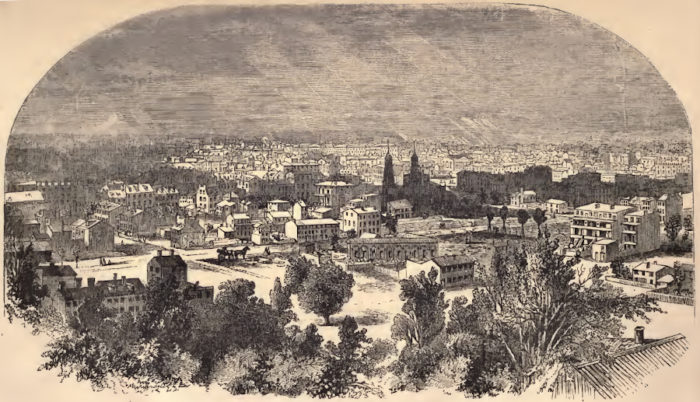
In my review of In the Shadow of the Capitol last week, I used a picture that the authors had found in a guide to Washington DC that I was not previously aware of: Dr. John B. Ellis’s 1869 Sights and Secrets of the National Capital: A Work Descriptive of Washington City in All Its Various Phases. Given its age, it was not difficult to find a copy online. I will look at a few of the Capitol Hill sites it mentions over the next few weeks, but today I will concentrate on the author, and one site near to my heart: Congressional Cemetery.
Other than that he styles himself a doctor, no bibliographic information exists on John B. Ellis. A review published of the book in the Manitowoc, Wisconsin, Tribune states that the “long residence of the author of this book in Washington and intimate acquaintance with all the varied phases of Washington life peculiarly fit him for the preparation of such a work.”
A year later, he wrote another book, Free Love and Its Votaries or American Socialism Unmasked. Here, he is listed only as “Author of Sights and Secrets of the National Capital etc., etc.” The year thereafter, John Humphrey Noyes wrote a book defending the Oneida Community from the attacks perpetrated on this group by the Ellis book. In it, Noyes writes that “no such man as Dr. John B. Ellis is known in literary circles.” and that the name is in fact a pseudonym for “a literary gentleman living in the upper par of the city, who does not wish to have his named mentioned in connection with it.”

It is thus no surprise that his book on Washington spends a fair bit of space describing the tawdrier corners of the city, but there is also a section on Congressional Cemetery, which begins,
This beautiful cemetery covers an area of nearly twenty acres, and is located upon the high ground immediately overlooking the “Anacostia,” or Eastern branch of the Potomac. It is the property of one of the Episcopal churches of the city, by which it is kept in order.
There follows a paragraph about its name and the fact that there are cenotaphs for each of those congressmembers who died in office. The third paragraph describes the public vault, as the – brief – resting place for both President Zachary Taylor (listed as “General Taylor,” however) and John C. Calhoun, failing to mention Presidents William Henry Harrison and John Quincy Adams, who both spent some time there.
There are then two pages of quotations from gravestones in the cemetery, including both Vice Presidents and Pushmataha (pictured) At the end of this is a brief section listing some of the other inmates, including William Wirt, Archibald Henderson, and two ex-Mayors of Washington, Towers and Maury.
In short, it is a good overview of a cemetery that was still very much in its embryonic stage at this point – no gate house of chapel had been built yet, for instance – and, of course, no way to know that the last cenotaph has been placed already, and that the cemetery place as a national cemetery would soon be usurped by Arlington Cemetery, across the river.
Next week: Bring on the scandals!
